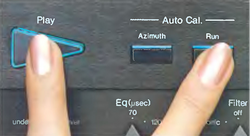A.B.L.E. (Azimuth, Bias, Level, Equalizer)
The Extraordinary Auto-Calibration Computer That Achieves A Response Of 18-25,000 Hz ± 3 dB
-
The cassette format is capable of far better performance than most audiophiles realize. To achieve it requires extraordinarily precise adjustment of four critical recording parameters - Azimuth, Bias, Level, and Equalization - to match the characteristics of the particular tape being used.
-
Bias, Level, and Equalization are electrical parameters, and cassette recorders that afford manual control over one or two of them have been available. Manual adjustment of all three is very tedious since the functions interact in such a way that adjusting any one requires readjustment of the other two. Such "iterative" adjustments are simple work for a computer that can make many corrections per second.
-
Operation of the A.B.L.E. Computer
The "brain" of the A.B.L.E. computer is an 8-bit microprocessor capable of independently adjusting bias, level, and recording equalization through a 256 step range, separately for left and right channels. There is no need for a tape selector switch since the wide control range encompasses all of today's tapes and provides for the future too.
-
Simultaneously pressing PLAY and RUN starts the computer which then follows the procedure of the flow chart. First, azimuth is adjusted since an error of only 0.1 degree results in more than a 3-dB loss at 25 kHz. This Nakamichi exclusive is absolutely essential to achieve wideband in phase recordings. After preliminary adjustments, the computer checks response and begins an iterative refinement. The recording equalizer is separated into two circuits linear and 6 dB/octave each of which is manipulated to achieve utterly flat response (20-20,000 Hz ±0.75 dB).


 3 Heads
3 Heads

